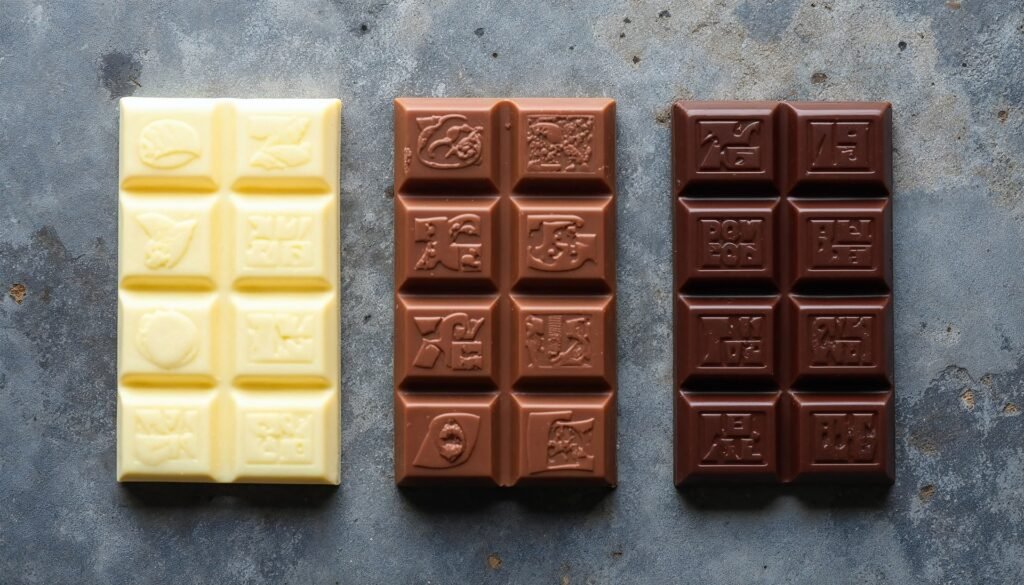White Chocolate vs. Milk Chocolate vs. Dark Chocolate
- Category: Blogs
White Chocolate vs. Milk Chocolate vs. Dark Chocolate: 3 Shocking Truths About What’s Best (and Worst) for You!
Chocolate lovers often have a favorite variety: white, milk, or dark. Each type offers distinct flavors, textures, and health benefits, making the debate about which is best a matter of personal taste and preference. Let’s dive into the differences among these three popular types of chocolate and what makes each one unique.
1. What Makes Each Chocolate Type Unique?
Before we explore the benefits and drawbacks of each, it’s essential to understand what goes into making Dark, milk, and White chocolate.
-
Dark Chocolate is made with cocoa solids (cocoa powder), cocoa butter, and sugar, with little to no milk. The cocoa content can vary, but it’s often above 60% and can even reach 90-100% in more intense varieties.
-
Milk Chocolate contains cocoa solids, cocoa butter, milk (in the form of milk powder or condensed milk), and sugar. The milk content gives it a smoother, creamier texture and a sweeter taste compared to dark chocolate. It typically has around 10-50% cocoa content.
-
White Chocolate contains no cocoa solids at all. Instead, it’s made from cocoa butter, milk, and sugar, giving it a creamy, rich flavor without any of the cocoa taste associated with dark or milk chocolate.

2. Baking and Cooking: Which Chocolate Works Best?
Different recipes call for different types of chocolate. Here’s a quick guide to help you decide which to use when baking or cooking:
- Dark Chocolate: Great for rich, intense desserts like brownies, chocolate cakes, or truffles. It also pairs well with flavors like orange, raspberry, and coffee.
- Milk Chocolate: Ideal for creamy desserts like mousses, milk chocolate chip cookies, and chocolate bars. Its smooth texture works well in dairy-based recipes.
- White Chocolate: Popular in delicate desserts like panna cotta, white chocolate mousse, and ganache. White chocolate also makes a lovely contrast when paired with berries or tart fruits.
3. Nutrition Comparison: Dark, Milk, and White Chocolate
When comparing Dark, milk, and White chocolate nutritionally, we find significant differences in their content of cocoa solids, sugar, fat, and other nutrients. Here’s a general breakdown of their nutritional profiles per 1 oz (28g) serving:
| Nutrient | Dark Chocolate (70-85% cocoa) | Milk Chocolate | White Chocolate |
|---|---|---|---|
| Calories | 170 | 150 | 153 |
| Total Fat | 12g | 9g | 9g |
| Saturated Fat | 7g | 5g | 5.5g |
| Sugar | 6g | 14g | 16g |
| Fiber | 3g | 0.5g | 0g |
| Protein | 2g | 2g | 1g |
| Calcium | 2% DV | 8% DV | 6% DV |
| Iron | 6% DV | 2% DV | 0% DV |
Note: DV = Daily Value based on a 2,000-calorie diet. Actual values may vary depending on the brand and exact cocoa content.
Healthier Choice: Dark Chocolate
It generally stands out as the healthiest option due to its higher cocoa content and lower sugar levels. Here’s why dark chocolate ranks highest nutritionally:
-
Antioxidants: Dark chocolate contains more flavonoids, particularly epicatechin and catechin, which are antioxidants that help reduce inflammation, improve blood flow, and may lower the risk of heart disease.
-
Less Sugar: With around half the sugar content of Dark or Milk Or White chocolate is a better choice for those monitoring their sugar intake or aiming to avoid sugar spikes.
-
Higher Fiber Content: Dark chocolate has more dietary fiber, which can aid in digestion and help you feel full longer.
-
Potential for Heart Health: Some studies show that consuming dark chocolate in moderation can improve heart health by lowering blood pressure, reducing bad cholesterol, and boosting good cholesterol.
However, dark chocolate has more saturated fat per ounce, so portion control is still essential.

Taste Test: Which Chocolate is More Delicious?
The answer to this question often depends on individual preference, but let’s look at whars in terms of taste and texture:
-
Dark Chocolate: Known for its bold, rich flavor, dark chocolate can be an acquired taste due to its slightly bitter and earthy notes. Dark chocolate enthusiasts often appreciate its depth and intensity. It’s a favorite among those who enjoy robust flavors without excessive sweetness.
-
Milk Chocolate: Milk chocolate’s creamy texture and sweetness make it highly popular, especially for those who enjoy a balanced, milder chocolate taste. The milk softens the bitterness of cocoa and brings out a subtle sweetness, which many people find comforting and indulgent.
-
White Chocolate: White chocolate is the sweetest of the three, thanks to its lack of cocoa solids and higher sugar content. Its taste is rich, vanilla-like, and creamy, with none of the bitterness found in dark or milk chocolate. This makes it ideal for those with a sweet tooth or those looking for a dessert-like flavor.

Which Chocolate Should You Choose?
White, milk, and dark chocolate each have their own unique qualities and offer different benefits. It’s completely upto you. I can just give you some hints about Which will be best for which purpose
For Health: Dark chocolate is generally the healthiest choice, thanks to its higher concentration of antioxidants, fiber, and lower sugar content.
For Taste: If you enjoy a sweet, creamy flavor, milk chocolate or white chocolate may be more satisfying. Dark chocolate appeals to those who enjoy bold, rich flavors with a hint of bitterness.
Now It’s Upto to You whether you choose Health or Taste.
2 thoughts on “White Chocolate vs. Milk Chocolate vs. Dark Chocolate: 3 Shocking Truths About What’s Best (and Worst) for You!”